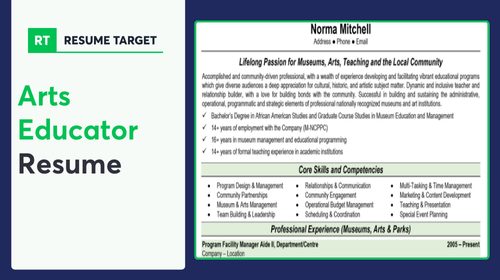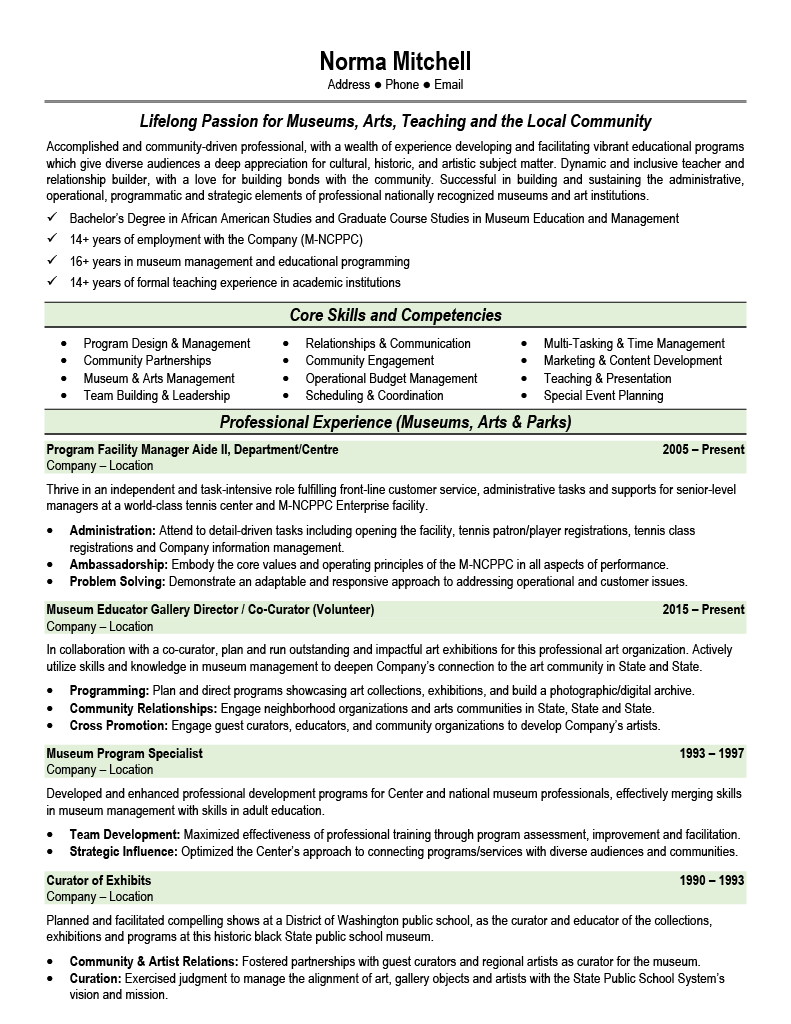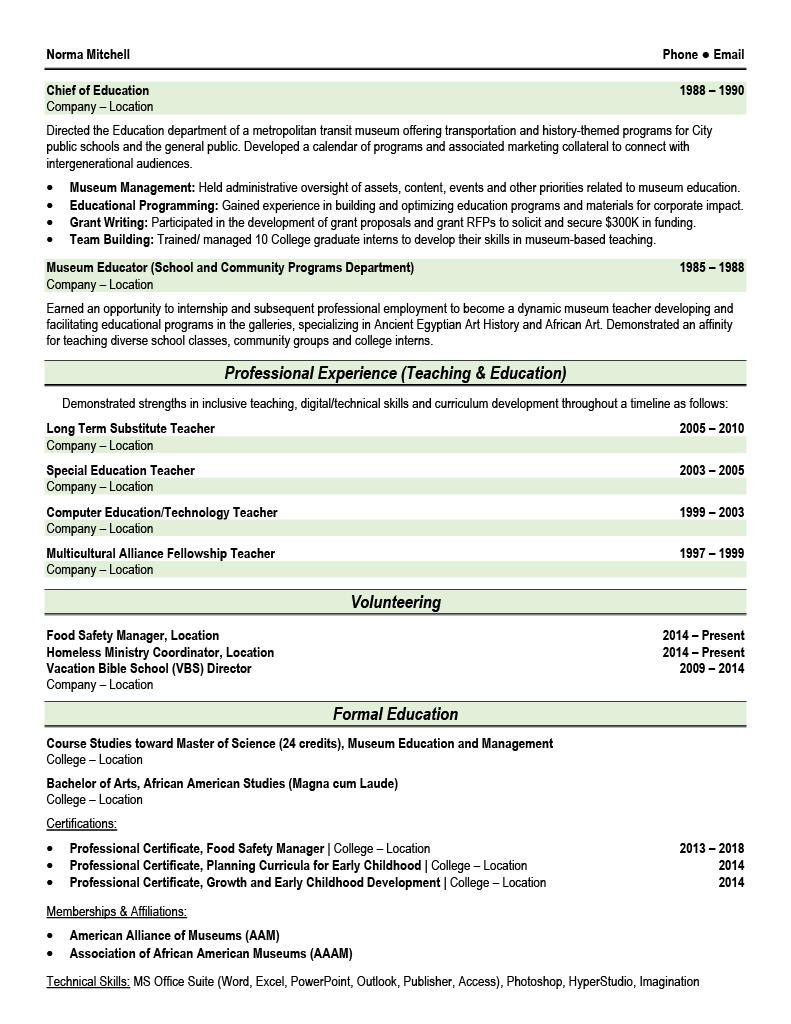

Creative professionals often find it challenging to translate their artistic impact into resume-worthy achievements. Teaching art requires a unique blend of creative talent and educational expertise that standard resume templates just don't capture.
Are you struggling to showcase both your artistic abilities and teaching excellence on paper? Your resume needs to paint a clear picture of how you inspire students while meeting educational standards and achieving measurable outcomes.
Resume Target specializes in helping arts educators transform their classroom victories into compelling career stories. We'll help you craft a resume that speaks to administrators and hiring managers while highlighting your creative approach to education and student success.


As creative education champions, arts teachers unlock students' artistic potential while teaching essential skills like illustration, sculpture, and various craft-based techniques that help young minds express themselves through visual media.
Your role as an arts teacher extends far beyond demonstrating brush strokes and color theory – you'll design engaging curricula, introduce diverse artistic mediums, provide constructive critiques, and create a classroom environment where creativity flourishes alongside technical skill development.
Whether you're just starting your journey in arts education or looking to advance your teaching career, the path ahead offers exciting opportunities to shape young artists, contribute to cultural education, and continually evolve your own creative and pedagogical expertise.
Let's talk about the exciting earning potential in arts education! As an arts teacher, your salary can vary significantly based on where and what you teach. Here's what's exciting: high school arts teachers typically earn more than elementary levels, and you can boost your earning potential substantially with advanced degrees like an MFA. And guess what? Public school positions tend to offer more competitive compensation than private institutions.
Figures from: Teacher.org
Starting as an Arts Teacher opens doors to diverse leadership opportunities in education. From classroom teaching to department leadership, your artistic expertise and teaching skills can propel you toward rewarding senior positions.
Beyond basic artistic abilities, advancing your career requires a blend of technical expertise, leadership capabilities, and innovative teaching approaches.
- Advanced artistic techniques (multiple mediums) - Curriculum development and assessment - Student engagement and classroom management - Mentorship and leadership abilitiesLaunch your arts teaching career by combining your creative passion with educational credentials, starting with a bachelor's degree in art education and obtaining your teaching license to inspire the next generation of artists.
To excel in this creative educational path, you'll need to develop proficiency in various artistic mediums and teaching methodologies, which you can build through student teaching and assistant positions.
Requirements from Academy of Art University
From bustling coastal states to growing midwest markets, arts education jobs flourish in both academic and cultural hubs.
Figures from Recruiter.com
Here's what's exciting: Your opportunities aren't limited to traditional classrooms. With colleges and universities offering mean salaries over $101,000, and even performing arts companies providing teaching positions at nearly $103,000, you can combine your passion for arts and education in various settings. Whether you're drawn to established cultural centers or emerging arts communities, there's a canvas waiting for your expertise.Struggling to translate your creative teaching experience and artistic achievements into a professional resume that speaks to both your educational expertise and artistic talents? This comprehensive, section-by-section guide will show you exactly how to craft a compelling arts educator resume that showcases your unique blend of teaching abilities and creative accomplishments.
As an arts educator, you know how to inspire creativity in others, but summarizing your own diverse talents and accomplishments in a few sentences can feel like painting a masterpiece with a single brushstroke.
While you excel at developing engaging curricula and fostering artistic growth in students, translating these dynamic teaching abilities into compelling resume language requires a different kind of creativity - one that helps hiring managers quickly visualize your unique value as an arts education professional.
How would you describe your unique approach to arts education and the creative learning environment you foster for students across different age groups and skill levels?
Reason: This helps establish your teaching philosophy and versatility as an arts educator, setting the tone for how you uniquely contribute to student development through artistic expression.
What combination of artistic disciplines and teaching methodologies do you bring to your role as an arts educator that makes you particularly effective?
Reason: This question helps articulate your professional identity by combining your artistic expertise with your educational capabilities, showing the full scope of what you bring to an arts education program.
How do you integrate contemporary arts practices, cultural awareness, and technological tools into your teaching to prepare students for today's creative landscape?
Reason: This demonstrates your modern approach to arts education and shows potential employers that you understand the evolving nature of arts education in contemporary society.
As an arts educator, you need to showcase both your artistic expertise and your teaching abilities, making your skills section particularly nuanced and multifaceted.
Your resume should reflect a blend of creative competencies (like studio art techniques or digital design tools) alongside educational skills (such as curriculum development and student assessment methods), while also highlighting your ability to manage classroom dynamics and foster artistic growth.
Showcase your creative teaching journey by organizing your experience into three impactful categories: your teaching role overview, measurable student achievements, and your innovative instructional responsibilities - this structure helps hiring managers quickly grasp your ability to inspire artistic growth and learning.
Many arts educators struggle to translate their creative teaching methods and student engagement into concrete, measurable accomplishments that administrators can understand. Transform your artistic impact into compelling metrics by connecting student growth, program development, and community engagement to specific outcomes that demonstrate your value as an arts education professional.
The responsibilities section demonstrates how Arts Educators shape creative learning environments and develop student artistic abilities. Your duties should highlight both technical teaching skills and the broader impact of arts education on student development, making it clear to administrators and hiring committees how you contribute to educational excellence.
Your educational background and teaching credentials form the foundation of your arts education career. Focus on highlighting your highest degree in fine arts or art education, along with any specialized certifications in teaching methodologies or specific artistic disciplines that demonstrate your expertise in both education and artistic practice.
Now that you've created a strong foundation using Resume Target's comprehensive resume writing guidelines, you're ready to transform your basic resume into a powerful tool for landing your dream teaching position.
While many arts educators focus solely on customizing their teaching portfolio and cover letter, tailoring your resume for each specific arts education position is equally crucial for standing out in this creative field.
A customized arts educator resume not only helps you navigate through automated ATS systems by incorporating relevant keywords, but it also demonstrates to hiring administrators how your unique artistic expertise and teaching methods align perfectly with their program's specific needs and educational philosophy.
Ready to turn your resume into your secret weapon? Let's make every word count and show those school districts why you're the inspiring arts educator they've been searching for!
Don't let a lack of formal teaching experience hold you back from pursuing your dream career as an Arts Educator!
Your creative background, combined with your education and student teaching experience, can create a compelling story that shows schools why you're the perfect candidate to inspire the next generation of artists.
Focus on highlighting your student teaching experience, relevant coursework in art and education, and any volunteer or leadership roles that demonstrate your ability to work with students.
For more guidance on crafting your education-focused resume, check out the Student Resume Writing Guide for templates and examples that will help you showcase your potential.
Your summary section is your chance to showcase your passion for arts education, highlighting your student teaching experience, creative projects, and educational achievements that make you an inspiring classroom leader.
Focus on demonstrating how your fresh perspective and contemporary teaching methods will create an engaging learning environment for students.
"Enthusiastic and creative Arts Educator with hands-on experience through student teaching and curriculum development in diverse classroom settings. Demonstrated success in designing and implementing engaging visual arts lessons for grades K-12, incorporating both traditional and digital media techniques. Skilled in fostering inclusive learning environments and organizing student art exhibitions. Seeking to inspire artistic expression and creativity while building fundamental skills in a progressive school environment."
Now's your chance to showcase the rich educational background that prepared you to inspire creativity in others - from your formal degrees to specialized certifications in teaching artistry!
Don't just list your credentials - highlight relevant coursework like "Curriculum Development in the Arts"and impactful student teaching experiences, plus any workshops or training in specific artistic disciplines that make you uniquely qualified to nurture young talent.
The following courses are common for an Arts Educator degree/certification: Introduction to the Teaching Profession, Teaching Strategies and Classroom Management, Learning Theory and Assessment, Analysis and Application of Ethical, Legal, and Safety Issues in Schools, Theory and Practice of Teaching ESOL Students in Schools, Content Reading in Kindergarten through Grade 12, History of Western Art II, Drawing Fundamentals I, Design Fundamentals-Two Dimensional, Introduction to Computer Art, Design Fundamentals-Three Dimensional, Drawing Fundamentals II, Beginning Ceramics, Beginning Painting, Beginning Photography, Teaching Art Appreciation & Criticism in the Classroom, Teaching Art in the Elementary School, Teaching Art in the Secondary School, Art for Exceptionalities, and Studio Experiences in Art Education [1].Relevant Coursework: Teaching Strategies and Classroom Management | Learning Theory and Assessment | Content Reading K-12 | Drawing Fundamentals | Design Fundamentals-Two Dimensional | Teaching Art Appreciation & Criticism
Key Projects:
Inclusive Art Curriculum Development: Designed and implemented a comprehensive K-8 art curriculum that integrated multiple mediums while accommodating diverse learning needs and cultural perspectives.
Collaborative Student Art Exhibition: Coordinated a school-wide art showcase featuring student works while incorporating cross-curricular connections with other subject areas.
Transform your academic training, student teaching experience, and creative abilities into a compelling skills section that showcases your readiness to inspire and educate through the arts.
As an aspiring Arts Educator, your unique combination of creative expertise and teaching abilities positions you perfectly to make a meaningful impact in students' lives while building a rewarding career in art education.
Let's face it - capturing the magic of your classroom creativity and student impact on paper feels like trying to paint a masterpiece with words alone.
At Resume Target, we specialize in helping arts educators showcase their unique blend of artistic expertise and teaching excellence, having helped countless creative instructors transform their experiences into compelling career stories.
Whether you're looking to advance in your current institution or explore new opportunities in arts education, don't let your incredible achievements go unnoticed - connect with us today to craft a resume that truly reflects your artistic vision and teaching impact.
Impress any hiring manager with our arts resume writing service. We work with all career levels and types of arts professionals.
Learn More → Arts Resume Writing Services